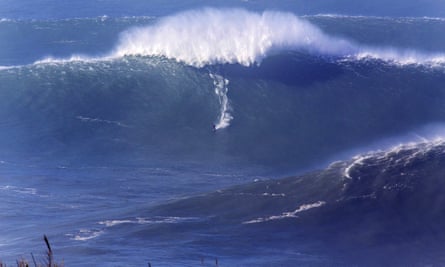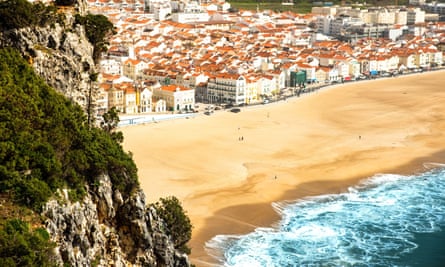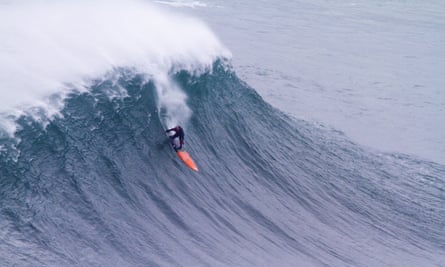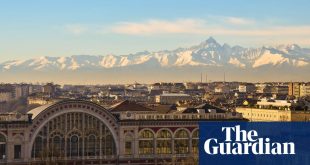Planning a trip around a natural spectacle is a risky business. How many people have planned a trip to see the northern lights, hoping to witness nature at its most dramatic, beautiful and extraordinary, only to come home disappointed?
In recent years, the gigantic Atlantic waves of Nazaré have been added to the traveller’s bucket list of seasonal phenomena. The Portuguese seaside town is the perfect spot to watch the towering behemoths of white water that rise up from Europe’s largest and deepest underwater canyon, 5,000 metres below the surface.
From November to March, the town becomes a magnet for big-wave surfers, an extraordinary group of men and women who are towed to the crest of the wave by a jetski partner, before hurtling down its face. As longtime sea lovers who have holidayed in Croyde and Newquay countless times, my partner and I can’t resist the chance of watching someone surf a wave three times the height of our house (and cracking along at over 50mph), particularly if it means escaping to Portugal in the depths of winter.

From the moment we book our trip, we monitor Wind Guru, hoping for the right combination of swell and winds to power the great tranches of water up from the canyon. I wonder, too, what else there will be to do in Nazaré in February, particularly if the seas are calm. Are we going to pitch up in a town snoozing through the colder months, waiting for spring’s first wave of tourists.
It’s all blue skies and sunshine when we arrive in Lisbon, and after a couple of days exploring on foot, fuelled by too many pasteis de nata, we hit empty roads for the two-hour drive north. When we reach Nazaré, wehead straight for the old town, Sitio, on the 300-metre-high headland that separates the calm waters of Praia de Nazaré from the tempestuous breaks of Praia do Norte. It’s the ideal viewpoint for watching the monster waves roll in.
In a stroke of luck, we have timed our visit to coincide with such a major swell that the surfing powers-that-be have decided to hold the Nazaré Tow Challenge during our stay. So much for a snoozy out-of-season town. We park at the Sitio to find pop-up food-trucks lining the path to the headland, TV vans rumbling past, and dozens of other visitors – many carrying serious cameras – heading towards the lighthouse.
Nothing prepares you for the first glimpse of Praia do Norte. It is a vast expanse of beach – a wide curve of sand stretching down to broiling, frothing white water that rushes in from different angles, colliding with itself, crashing on to the shore. The waves themselves are genuinely breathtaking – great, glittering walls of water that rise and teeter, then curl in on themselves, filling the air around us with a deep, shuddering roar and a fine mist of spray.

They are 10 or 12 metres high on our first day – small beans for Nazaré, but gargantuan to us. After gazing for an hour or so, we walk 10 minutes inland to Sitio’s busy square, with its whitewashed houses and widescreen views. We grab the last table at Casa Pires, a small, low-slung restaurant opposite the town’s imposing church. Fresh sardines come with homemade chips and a pile of salad; around us, families and groups of friends are diving into platters of fresh fish, and passing round sizable carafes of wine.
Our hotel is to the south, in the main part of Nazaré. It’s a long sprawl of low-rise houses and shop along the wide Praia da Nazaré. In summer, the beach draws Portuguese visitors who come for the acres of sand and calm, clear sea that give little clue to the drama taking place on the other side of the headland. Even in low season, the souvenir shops and ice-cream parlours along the front are busy and restaurants are full. Only when we venture out in the evening does it feel a little deserted, with many restaurants in the tangle of lanes behind the seafront virtually empty.

We happen across one buzzy spot, restaurant Canastra a Grelha, and settle in to eat succulent carabineros – giant prawns – and a steaming cauldron of caldeirada, a classic fish stew of monkfish, prawns and pleasingly nutty rice. The broth is so rich and flavoursome that we spoon it up greedily, mopping the last of it with bread. But it’s dessert that is the most unusual: molotof is an extraordinary meringue pudding, baked in a bain-marie to keep it soft, slathered with a rich caramel sauce.
With all the eating, the stiff half-hour walk back and forth to the headland proves to be a good thing. On the day of the Tow Challenge, we take the funicular up to Sitio, gliding slowly past the whitewashed houses that cling to the vertiginous slopes. When we arrive at the lighthouse, several hundred people are already sitting on the grassy slope above Praia do Norte, all with their gaze fixed on the surreal spectacle of towering waves bisected by a minuscule white line, as a surfer hurtles down its face.

Four hours later, when we have sat, unmoving, watching wave after wave, we agree it is one of the most incredible spectacles we have ever seen. It helps that Nazaré is still not commercialised: there is no fee to walk out on to the headland, where you can sit where your like, no souvenir shops or tacky cafes. There are just a couple of makeshift stalls and a lone guitarist, sitting on the hillside singing surf-hippy songs. It strikes me that even if we had arrived to find calm seas and small waves, it would still have been a delightful break from the gloom of an English winter.
The trip was organised by Portuguese Tourist Board. Accommodation was provided by Emerald House Lisbon (doubles from €133 room-only) and Hotel Maré in Nazare (doubles from €80 B&B)
 Top Naija News: Nigerian News, Breaking News Nigeria and World News Top Naija News is a daily news publication in Nigeria, delivering the latest breaking news in Nigeria and around the world.
Top Naija News: Nigerian News, Breaking News Nigeria and World News Top Naija News is a daily news publication in Nigeria, delivering the latest breaking news in Nigeria and around the world.



